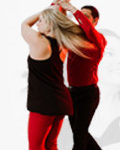Developing your own style is a challenging task.
Ten years ago, picking up a style variation from a pro would require booking a private lesson, buying an event tape, or watching really carefully from the first row of the ballroom.
Now, you can find literally days of footage on YouTube from almost any pro you can name. In this post, it’s time to learn how to put that video library to use.
We’re goanna tackle how learn from YouTube and use it to create your own styling in 2 easy steps.
Create your own styling in west coast swing
Step 1. Steal styling from Pros on YouTube
This exercise will focus on how to watch videos in order to pick up styling ideas.
We’re going to be using YouTube to help us today!
First you should subscribe to the WCS Online YouTube Channel
If you’ve not done that already – You can do that here!
It’s another way to keep up with our awesome free stuff
Then grab a notebook and sit down in front of a computer. Do a search for your favorite pro on YouTube. Pick a video and watch the whole dance, making note of the times when you see movements that you’d like to learn.
When you’re finished with the dance, rewind the video clip to the first moment you marked in your notebook. Go back a little further so you can see the start of the pattern. Your first task is to identify where the styling is occurring. Is it an anchor variation? A shape during a spin? A line out of a hip catch?
You probably know that west coast swing is a two-beat dance, and you should know how to break down patterns into their basic components.
Use this knowledge when you analyze the movement. It’s much easier to identify the movement if you can isolate what it is (e.g., a four beat alternating triple sequence, a syncopated right triple).
Now, rewatch the movement while covering the top and bottom of the screen with sheets of paper. You should only be able to see the dancer’s torso. Pay attention to what moves when. Is the upper body shaping in a certain direction? When does that movement begin and when does it finish? For this step, it can be helpful to watch the video in slow motion.
Do the same for the other body parts you can see: watch for the movement of the arms and the shoulders
Once you have identified what is moving in the torso, lower the sheets of paper so you can only see from the knees to the lower edge of the rib cage. Again, watch for what parts are moving when, in slow motion if necessary. Is the hip settling? Rotating? Is the hip moving with the core or in isolation?
As you continue to view parts of the body in isolation, you will gradually discover the elements in the pro’s movement. The next step is to figure out how they fit together, which will be our next topic!
Step 2. Creating your own styling
You’ve been watching your favorite pro and have found a cool styling variation that you want to learn. How do you move it from their body to yours?
Previously, we have talked about how to observe pros to identify styling movements. Now, you are going to practice recreating one of those movements.
The Drill: The first step in recreating the movement is finding a couple of checkpoints that you need to pass through. Find more than the starting and ending position.
Are there specific positions that the body goes through during the move? Identify those.
Remember that you can play the video back in slow motion to help with this process.
Once you have identified a couple of checkpoints along with your starting and ending position, it’s time to figure out how to move between those points.
This part of the exercise is difficult because there are no universal answers. Although movement is usually initiated in the core, that’s far from a universal rule (especially when dancers are doing unusual styling). The best way to approach this process is trial-and-error.
The good news is that you don’t have to discover the exact sequence of the original move; in fact, it’s very likely that you will find your own version of that movement, which is even better than just copying what you see others do.
Even though not every movement will start from the core, that’s a good place to start your experiment.
Try initiating the movement from the center, then from the hips, then from the ribcage. Try each starting point slowly several times, and use a videocamera to assess your attempts before deciding that the motion isn’t working.
Remember that you are both trying to learn what the movement is, and learn how to perform that movement. Be patient, and don’t jump to the conclusion that your method isn’t right too quickly.
If none of the above starting points work, you can start experimenting with parts of the body further from the center, like the shoulders, knees, feet, and arms.
Remember to be patient with yourself!
This process can be frustrating at times, but the advantage of going through this work (as opposed to just having someone tell you what to do) is that you will learn immeasurably more about how your body works.
Every time you work through this process, you are developing your kinesthetic sense so that you can pick up additional movements more rapidly in the future.




 Brian & Megan
Brian & Megan